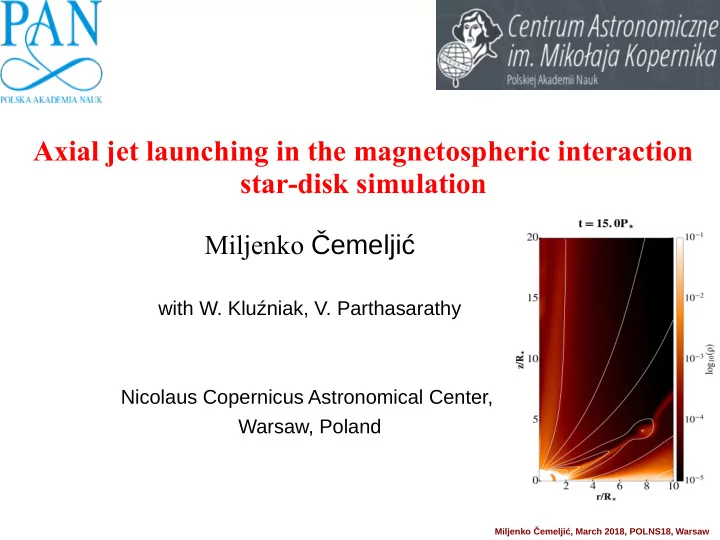

Axial jet launching in the magnetospheric interaction star-disk simulation Miljenko Čemeljić with W. Kluźniak, V. Parthasarathy Nicolaus Copernicus Astronomical Center, Warsaw, Poland Miljenko Čemeljić, March 2018, POLNS18, Warsaw
Outline • Introduction • Disk solutions • Axial and conical jets • 2D model for 3D lightcurve • Summary Miljenko Čemeljić, March 2018, POLNS18, Warsaw
Introduction •I perform long-lasting simulations of accretion disks, which reach a quasi-stationary state. •With PLUTO code I solve 2D axi-symmetric viscous & resistive MHD equations: •We neglect Ohmic and viscous heating in the energy equation. We still include viscosity and resistivity in the equation of motion and in the induction equation. Miljenko Čemeljić, March 2018, POLNS18, Warsaw
Simulations of the star-disk magnetospheric interaction All the simulations start with the same initial and boundary conditions, the Kluźniak & Kita (2000) solution of the hydro-dynamical disk in the full 3D (KK00). Such a disk is an analytic solution, obtained by the method of asymptotic approximation. We do not have the solution for the MHD case, so we perform numerical simulations. We add the stellar dipole field to the KK00 solution. We add a star as a boundary condition at the origin of the (spherical) computational domain. We assume the star to be a solid magnetized rotator. The initial corona is non-rotating, in a hydrostatic balance. I performed a systematic study with magnetic star-disk numerical simulations where the disk quasi-stationarity is reached-I will show a part of it later. Miljenko Čemeljić, March 2018, POLNS18, Warsaw
Star-disk simulation setup Resolution is Rx ϑ =[182x50] grid cells in ϑ =[0, π/2 ], with a logarithmic grid spacing in the ● radial direction. The accretion column is well resolved. Star rotates at about 1/5 of the breakup rotational velocity. ● Miljenko Čemeljić, March 2018, POLNS18, Warsaw
Reincarnated stars: Star-disk simulations of millisecond pulsars ● Ј sw --- ј axout The time dependence of the mass and angular Zoom into the central part of the system after 950 momentum fluxes in the various components pulsar rotations to visualize the accretion column and in our simulations after the quasi-stationarity the magnetic field lines connected to the disk beyond is reached. the corotation radius Rcor=2.92 Rs. Miljenko Čemeljić, March 2018, POLNS18, Warsaw
The jet launching I obtained a continuous launching of an axial jet from the star-disk magnetosphere. The axial jet and the conical outflow are launched after the relaxation from the initial conditions. They are similar to the results in Romanova et al. (2009) and Zanni & Ferreira (2013). Zoom into the launching region. Miljenko Čemeljić, March 2018, POLNS18, Warsaw
Part of the “atlas” of solutions with different resistivity Ω s =0.1 Ω s =0.2 α m =0.1 α m =0.4 α m =0.1 α m =0.4 α m =1. α m =0.7 α m =1. α m =0.7 Miljenko Čemeljić, March 2018, POLNS18, Warsaw
Trends in the simulations results Shown is the average angular momentum flux change with resistivity ( α m ) in various components of the system , ј tot ј s normalized to the stellar angular momentum. Dotted, dashed, dot- α m α m dashed and solid lines represent fluxes in Ω s =0.05, 0.1, 0.15 and 0.2 cases. We are interested in trends. ј R>Rcor ј sw Compared with observations, this will be used to improve the stellar models. α m α m Results presented here will be used to validate the results in our work on the magnetic Kluźniak & Kita disk in the ј out asymptotic approximation. ← -- Here is shown angular momentum flux change with Ω s, in the conical outflow Ω s case (with α m =0.1 ) . Miljenko Čemeljić, March 2018, POLNS18, Warsaw
Connection to observations: 2D model for 3D light curve The emission integrated along the stellar rim one grid cell thick in the azimuthal direction. The solid, dotted, long-dashed and short- dashed lines represent the intensities for an observer positioned at a co-latitudinal angle θ =15, 30, 60 and 165 degrees, respectively. Miljenko Čemeljić, March 2018, POLNS18, Warsaw
Connection to observations: 2D model for 3D light curve The dotted and dashed lines show the intensity for modeled hot spots as seen from the co-latitude angles of θ = 15 and θ = 165 degrees. Intensity is negative when the spot is not visible from a given position. In solid line is shown the total intensity for an observer with θ = 165. Switching of the accretion column from the southern to northern hemisphere produces a phase shift in the observed intensity peak as the star rotates. Miljenko Čemeljić, March 2018, POLNS18, Warsaw
Summary -I performed long-lasting star-disk magnetospheric interaction simulations of millisecond pulsars, to obtain relaxed disk solution. -Axial and conical jets are launched after the disk relaxation. -Launching of both, or only one of the outflows, depends on the position in parameter space (Ω s , resistivity, viscosity, B). -We have a working computation of the 3D intensity curve modelled from 2D simulations. Miljenko Čemeljić, March 2018, POLNS18, Warsaw
Recommend
More recommend